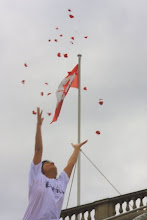I've watched you social entrepreneurs from afar. A bit like hanging out at the school gates, not quite part of the group, seeing you play in the playground, wondering if I can be your friend.
The reality is, probably no. Or perhaps yes. Perhaps once you've read this blog post, you could feed me inspiration, thought-provoking ideas?
See, my passion is a difficult thing. My passion is to inspire behavioural change in one of the most complex, culturally sensitive, difficult areas.

Photo: Nick Cornwall
I travelled to Ethiopia last year, as a volunteer with VSO. I did all my reading and preparation. But really, nothing prepared me for female genital mutilation. I'm not sure anything can. In some ways, I feel I was lucky, in that my introduction to it was quite pure - there I was in Ethiopia, living a volunteer's life, interacting with Ethiopian people. How much better than casually coming across a book - perhaps it would not have mattered to me, if all I had done was read yet another news report about an atrocity happening in a far away land.
As it was, I met women, I met girls, much like these, in one of the most sacred places I'd ever been, Lalibela in the north of Ethiopia.
The knowledge that these girls are likely to have their clitorises and labia cut out is almost unbearable. Cut out because these parts offend. It is a tradition now so steeped in history that it predates both Christianity and Islam. It is a tradition that is so powerfully culturally embedded that mothers and grandmothers do it to their own daughters. The patriarchal appropriation is complete - women believe by doing this that they are freeing their girls from the ugliness of genitals that if left, would grow down to their knees. The smell would be horrific. The irony is of course, that so many girls who are cut go through lifelong issues of repeated infections and odours.
More and perhaps most importantly, by going through this ritual, their daughters are cleansed for marriage. An uncut woman will remain unmarried. And in Ethiopia, that means she will remain status-less. It is literally inconceivable to be unmarried.
So what is at the root of FGM? Clearly, female control. But it is wider than this. It's done to ensure first virginity, then chastity. This is because its most extreme form, infibulation, means that the wound is also sewn up. A hard plug of scar tissue forms - literally the body's own chastity belt. This is then cut open, on a girl's wedding night (because child marriage is still the norm) and also at every subsequent birth - cut open, sewed back up again.
There are other reasons. Even though it predates religion, many people believe that it is part of Islamic culture. Few imans preach against it. Most in fact believe it is the same status as male circumcision, which is promoted in the Qu'ran. Christiantiy too in Africa remains pretty silent about it.
So enough of the FGM lesson. Why am I standing at the school gates, nose pressed, looking in?
Because a social enterprise, as far as I can work out, needs an income stream. What income stream to help these girls? What income stream attaches itself to behavioural change? Perhaps training - but this issue needs community driven, embedded work. On a massive scale. It needs advocates within communities, not do-gooders from across the seas telling others how to live their lives.
All I can think of is a straightforward model of fundarising here to channel to those over there. The intervention? Community based education. Community health workers who can tell of the links between girls' problems and FGM. Wholescale community shifts towards allowing girls who are not cut to be married (very achievably - this is the UNICEF/Innocenti approach, predicated on game theory). Giving circumcisers economic alternatives to support their livelihoods. Asking National Governments to enforce their own laws that ban FGM (in 24 of the 28 practising countries) and asking international players to really step up to the plate and start using their influence.
So, that's an introduction to the vagaries of FGM.
I hold those little girls in my mind though, as I go through trying to make sense of all this. I've given up full time work to both volunteer on this but also to somehow make some practicable change. I find the NGO world difficult to penetrate, obscure and behemoth like. The private sector has little interest, for obvious reasons. Little girls in Africa? The funding world finds little to do, concentrating on infectious diseases like malaria.
I found myself on the plinth on day 4. It was a remarkable humbling experience to stand in orange, pull on 40 different t-shirts all with different countries and then cut the petals of a red rose and fling them into the air, with the words: "This is for the three million girls around the world, who will be cut this year." The crowd stayed with me. Afterwards, people came up to me, put their arms around me. One man in a disabled buggy came over and simply said, "I didn't know. I just didn't know - thank you." That seemed to say it all.



